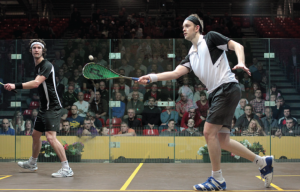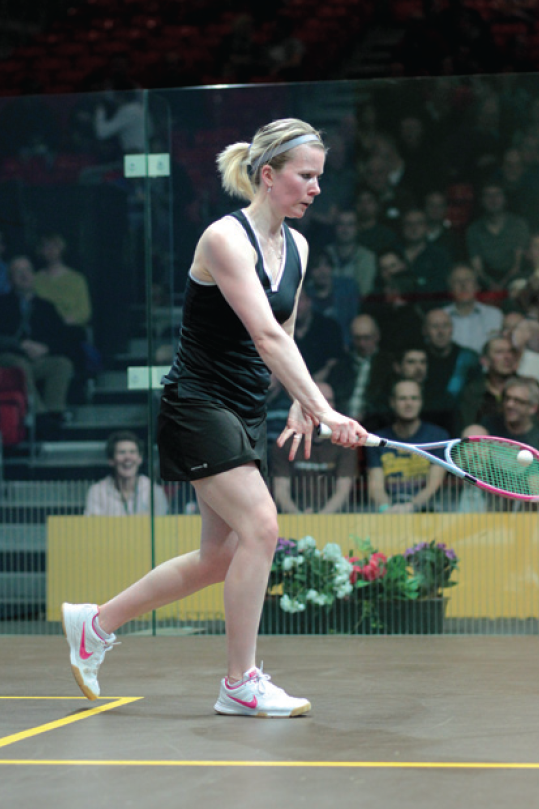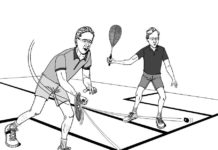By Barry Faguy, WSF Referees and Rules Committee
Here’s the second in a short series of short articles dealing with what can be called ‘conventions’—used here in the sense of ‘understandings’ where we don’t necessarily follow the letter of the law. You can re-read the full intro with the last edition but, for now, let’s go to the second convention.

THE FOOT-FAULT CONVENTION
If a player’s return touches a line by a quarter-inch, you can be sure that, should you not call it, you’ll get an earful from the opponent. But…a foot-fault!? A server can often be over-stepping by one or two feet—and nary a word is heard! I think few people would deny that the vast majority of foot faults go unheeded—both by players and by officials. Why is that so? And what are you to do about it when your turn comes to referee a match?
The Thinking
Unlike the issue of a ball hitting a line, I’d suggest that the explanation for this lack of attention to foot-faults is the conventional feeling that it really doesn’t matter much. Most folks just believe there’s simply not that much to be gained if that foot is not in the right place—even with a major foot-fault. That’s not to say that there isn’t an attendant feeling that it would be nice if the server’s foot was at least in the ball park—but other than that, it’s pretty clear that few people actually care about it the way they care about a shot hitting the top of the tin. Some actually consider a referee who does call foot-faults a bit of a pedantic nerd!
It’s difficult to deny that not calling foot-faults really is a convention of play—both in everyday use and at the professional level. If you doubt that, check out some PSA match videos on YouTube. For the most part, it seems to have always been that way. So the question comes up about why you, as a referee, should bother about it. Here are some thoughts:
The Considerations
- Rules are rules Without a rule of course, the service procedure would be a zoo. The rules set standards around which the game can take place and, as a referee, you are entrusted to enforce them. However, you need to be aware where these parameters sometimes vary in their application in different environments.
- The slippery slope With constant disregard of the rule, the ‘slippery slope’ principle has the potential to kick in among some players—and some can doubtless take things too far and start serving from any and every conceivable place to such a degree that it might indeed foster an advantage for one player.
- The difficulty of the call It is often a challenge to recognize if there actually is a foot-fault. In contrast to a ball hitting a line at one point in space, declaring a foot-fault involves both monitoring the foot position which is in flux (with all positions potentially being legal), and simultaneously noting the higher-up moment of ball-to-racket contact (the moment that determines the legality of the foot position).
- The tendency to look up Sensitive to the potential for complaints that come with missing the front-wall fault, one’s natural tendency is to look up there exclusively. And to add to the viewing challenges, if all this occurs on a Show Court used with a professional event, the referee’s placement is often so far away as to easily qualify as a different postal zone than that of the players.
The Suggestions
- Change your attitude When you’re charged with the job of being the referee, look at the whole issue differently and decide that it matters. Start paying more attention and call them early when it’s blatant—and you are certain. The slippery slope effect includes not only the potential for increased player abuse of foot position, but the potential for embarrassing queries from players, spectators, and other officials when you don’t call them.
- Improve your focus Develop the routine of watching the feet at the start of every serve, then start to raise your visual focus to integrate the foot-position with the moment of ball-strike. Then, immediately center your attention to the front wall—because, as we said, missing a front wall fault is far less forgivable than the earlier foot-fault.
- If uncertain, say nothing As noted above, there are multiple factors involved, and certainty can be difficult. In the rare instance where the loser of the rally complains about a missed foot-fault, then of course you can fall back on the ‘uncertainty’ principle (13.2.3)—a perfectly valid option that leads to the fair decision of replaying the rally.
What about ‘warnings’?
There’s an anecdote about a player asking a referee why he wasn’t given a warning before having a foot-fault called. The referee answered by asking the player if there were any other rules he’d like to be warned about!
Now that’s a witty quip. However, because of the generally scattered nature of the application of foot-fault calls, there might be some merit for a referee to give such warnings —especially at lower levels of play. If you do it, do it early in the match. Simply state to both players that you have noticed that some serves are close to foot-faults. The players are now aware that they have a referee who’ll be paying attention. Of course, one cannot argue that the most effective warning for the next serve is an outright call of “Foot-fault!”
Finally, I can’t resist including a match announcement overheard at a local event some years ago. It was from a referee who had obviously made up his mind about this issue, when he said: “OK guys—I want a clean match here. No horse****! And by the way, I’m calling your foot faults. Best of five games—Love all!”





